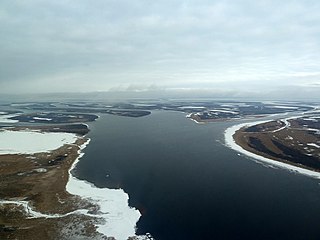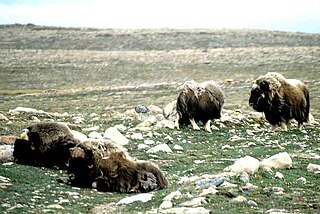Related Research Articles

A biome is a distinct geographical region with specific climate, vegetation, and animal life. It consists of a biological community that has formed in response to its physical environment and regional climate. Biomes may span more than one continent. A biome encompasses multiple ecosystems within its boundaries. It can also comprise a variety of habitats.

In physical geography, tundra is a type of biome where tree growth is hindered by frigid temperatures and short growing seasons. The term is a Russian word adapted from Sámi languages. There are three regions and associated types of tundra: Arctic tundra, alpine tundra, and Antarctic tundra.

An ecoregion is an ecologically and geographically defined area that is smaller than a bioregion, which in turn is smaller than a biogeographic realm. Ecoregions cover relatively large areas of land or water, and contain characteristic, geographically distinct assemblages of natural communities and species. The biodiversity of flora, fauna and ecosystems that characterise an ecoregion tends to be distinct from that of other ecoregions. In theory, biodiversity or conservation ecoregions are relatively large areas of land or water where the probability of encountering different species and communities at any given point remains relatively constant, within an acceptable range of variation . Ecoregions are also known as "ecozones", although that term may also refer to biogeographic realms.
The Global 200 is the list of ecoregions identified by the World Wide Fund for Nature (WWF), the global conservation organization, as priorities for conservation. According to WWF, an ecoregion is defined as a "relatively large unit of land or water containing a characteristic set of natural communities that share a large majority of their species dynamics, and environmental conditions". For example, based on their levels of endemism, Madagascar gets multiple listings, ancient Lake Baikal gets one, and the North American Great Lakes get none.

The Scandinavian montane birch forests and grasslands is defined by the World Wildlife Fund (WWF) as a terrestrial tundra ecoregion in Norway, Sweden, and Finland.

The Cherskii–Kolyma mountain tundra ecoregion is an ecoregion that covers the higher elevations of the Chersky Range and the Kolyma Mountains, the only large mountain range in northern Russia. It is in the Palearctic realm, and tundra biome. It has an area of 556,589 square kilometres (214,900 sq mi).

The Chukchi Peninsula tundra ecoregion is an ecoregion that covers the northern coast of Russia along the East Siberian Sea, a marginal sea of the Arctic Ocean. The climate is somewhat milder than would be expected for its latitude, but the moderating effects of the East Siberian Sea and Bering Sea permits summer daytime temperatures above 50 °F (10 °C). Many colonies of migrating birds visit the area. The ecoregion is in the Palearctic realm, and tundra biome. It has an area of 298,367 square kilometres (115,200 sq mi).

The Kamchatka Mountain tundra and forest tundra ecoregion is an ecoregion that covers the central mountain range of the Kamchatka Peninsula in the Russian Far East. The region is one of volcanos, caldera, geysers, and mountain tundra. It is in the Palearctic realm and tundra biome. It has an area of 119,400 square kilometres (46,100 sq mi).

The Kola Peninsula tundra ecoregion is an ecoregion that covers the northeastern half of the Kola Peninsula, along the coast of the White Sea, a marginal sea of the Arctic Ocean. The maritime effects of the White Sea create a milder climate than would be expected for a region of this latitude. It is in the Palearctic realm, and the tundra biome. It has an area of 58,793 square kilometres (22,700 sq mi).

The Northeast Siberian coastal tundra ecoregion is an ecoregion that covers the coastal plain of the central north region of Siberia in Russia. This coastal region borders the Laptev Sea and the East Siberian Sea, both marginal seas of the Arctic Ocean, from the Lena River delta in the west to the Kolyma River delta in the east. There are several large river deltas in the area that support breeding grounds for 60 to 80 species of migratory birds. The region is in the Palearctic realm, and the tundra biome. It has an area of 846,149 square kilometres (326,700 sq mi).

The Taimyr-Central Siberian tundra ecoregion is an ecoregion that broadly covers the Taymyr Peninsula in the Russian Far North. It ranges from the delta of the Yenisei River in the west, across the Taymyr Peninsula and Khatanga Gulf, to the Lena River delta in the east. The region is an important area for breeding birds. It is in the Palearctic realm in the tundra biome, and is mostly located in Taymyrsky Dolgano-Nenetsky District of Krasnoyarsk Krai. It has an area of 954,670 square kilometres (368,600 sq mi).

The Yamal–Gydan tundra ecoregion sprawls across the expansive Yamal Peninsula and Gydan Peninsula in the northern expanse of Russia. This unique ecoregion is characterized by its sparsely populated vegetation and wildlife, yet it holds great significance as a vital haven for migratory birds and coastal sea mammals. Embraced by the Palearctic realm and firmly entrenched in the tundra biome, it boasts an extensive area, covering approximately 412,067 square kilometers.

The Canadian High Arctic Tundra ecoregion encompasses most of the northern Arctic archipelago, from much of Baffin Island, Somerset Island, and Prince of Wales Island in the south, through all islands northward to the most northern island in Canada, Ellesmere Island. Much of the northern islands are covered in ice, and the climate is very dry with as little as 50 mm/year in places. The ecoregion has very little human habitation, and most of the non-ice terrain is moss and lichen cover. The region supports viable populations of arctic mammals such as muskox, arctic wolves, arctic foxes, arctic hares, polar bears, and caribou.

The Kalaallit Nunaat high arctic tundra ecoregion covers the coastal areas of northern including the upper half of the west coast and the upper one-third of the east coast. Greenland. Areas inland of this strip of land are either covered in ice or bare rock. About one-third of the region is covered by mosses and lichens, and another 3% by herbaceous vegetation and shrubs. The largest national park in the world, Northeast Greenland National Park, protects a majority of the land within the ecoregion. The Pituffik Space Base is also located in this ecoregion.

The Canadian Middle Arctic Tundra ecoregion covers a broad stretch of northern Canada - the southern islands of the Arctic Archipelago, plus the northern mainland of Nunavut and, across Hudson Bay to the east, a portion of northern Quebec. This is the coldest and driest ecoregion in Canada, and can be referred to as a 'polar desert'. It is an important region for breeding and migratory birds, and supports 80% of the world's muskox.

The Tundra of North America is a Level I ecoregion of North America designated by the Commission for Environmental Cooperation (CEC) in its North American Environmental Atlas.
References
- ↑ Eric Dinerstein, David Olson, et al. (2017). An Ecoregion-Based Approach to Protecting Half the Terrestrial Realm, BioScience, Volume 67, Issue 6, June 2017, Pages 534–545, https://doi.org/10.1093/biosci/bix014